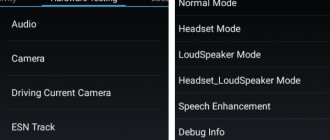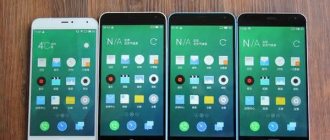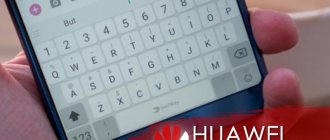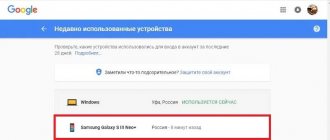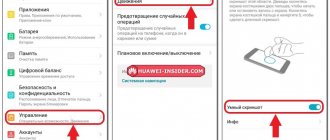Hello! If your sensor is dull and does not respond to requests, and when pressed it opens the wrong thing, then you should try calibration. The first step is to check your gadget for touch errors. For example, go to messages and click on different letters. If the display shows what you pressed, then this device does not need calibration.
Sensor options:
- Capacitive - often used, considered the best.
- Resistive is an outdated touchscreen that today can be found in old gadgets.
What Screen Calibration Can Fix
The sensors in new devices, if we are not talking about defects, respond to touches accurately. But over time, the response time may increase, there may be a partial or complete lack of response to presses, symbols on the virtual keyboard will be printed incorrectly, and other presses will be shifted to the side, as a result of which the necessary actions will not be performed.
So, if you notice delays after touching, when typing messages, the adjacent letter is printed instead of the desired one, or other inconsistencies with the request, calibration of the Android touch screen is necessary. This procedure involves software configuration of the correct operation of the touchscreen.
Touch display calibration is also performed in the following cases:
- Fall from a great height, damage to the device.
- Moisture getting inside the device body.
- The screen or sensor has been replaced.
- A protective glass was glued to the screen.
- Preventive maintenance for prolonged use of a smartphone or tablet.
Calibration using apps
h25,0,0,0,0—>
There are a large number of utilities that are designed to calibrate the sensor. There are paid and free versions, some of which require root rights.
p, blockquote26,0,0,1,0—>
There are streaks or smudges on your Android phone screen
p, blockquote27,0,0,0,0—>
ClinOmeter
h31,0,0,0,0—>
The app not only calibrates the touchscreen, but also changes the tilt height, tilt angle, and tilt of the object relative to gravity.
p, blockquote28,0,0,0,0—> p, blockquote29,0,0,0,0—>
SGS Touchscreen Booster
h32,0,0,0,0—>
The program is capable of optimizing the performance of the phone's sensor quite well.
p, blockquote30,0,0,0,0—> p, blockquote31,0,0,0,0—>
More subtle settings are also available:
p, blockquote32,0,0,0,0—>
- Touch filtering.
- Period before touch recognition.
- Changing the number of simultaneous touches.
- Minimum pressing force.
The utility has ready-made settings that you just need to select. It is best to carry out manual configuration.
p, blockquote33,0,0,0,0—>
Touchscreen Calibration
h33,0,0,0,0—> p, blockquote34,0,0,0,0—> p, blockquote35,0,0,0,1—>
A fairly simple program that has a “Calibration” button in the interface and a section for it. Working with the program is simple and clear.
after—>
Mobile gadgets with touch screens appeared around the middle of the last century, and quickly gained popularity, displacing conventional push-button phones. Currently, touch screens are widespread: tablets, smartphones, laptops, game consoles, navigation devices are equipped with an information input/output system, which allows you to interact with objects shown on the screen by touching with your fingertips. However, as you use the smartphone's touchscreen, it may not respond well to touch: it may not respond or execute commands that are not required. If such a problem arises, there is no need to rush to the store to buy a new gadget. It is enough to simply adjust the operation of the sensor.
What types of sensors are there in a smartphone and why are they needed?
Modern mobile devices have a large range of sensors, and occasionally among them there are unusual options such as measuring ambient temperature and humidity, ultraviolet radiation and pulse, as happened with the Blackview BV9900 smartphone.
But the standard set includes completely different, more familiar sensors.
The most popular of them can be safely called the accelerometer. Designed to measure acceleration along three coordinate axes (X - transverse, Y - longitudinal and Z - vertical) taking into account gravity. Thanks to the data received, the smartphone seems to begin to understand its position in space, and functions such as auto-rotating the screen or launching applications by shaking the smartphone appear.
The second most popular is the proximity (or proximity) sensor, which turns off the screen during phone calls if the smartphone is near the ear (or any other part of the body). And it can, on the contrary, prevent the display from turning on when the device is in your pocket.
An ambient light (light) sensor is also almost always used, with the exception of rare budget models. It measures the level of ambient light in lux, and is responsible for automatically adjusting the brightness depending on external conditions. Moreover, in some smartphones, auto-brightness cannot be turned off, and along with the backlight, the saturation of color shades can also change.
Through a magnetometer (compass), the external magnetic field is measured, or rather its strength along three axes. As you might guess, a compass is needed to determine the cardinal directions, and it also simplifies the work with navigator applications - on maps it is much faster to determine the direction of movement. Unfortunately, not all smartphones have a magnetometer anymore, but it may well be found in a budget device.
A gyroscope, which is sometimes confused with an accelerometer, actually works in tandem with it and is useful for measuring speed around the X, Y and Z axes. Without a gyroscope, it is impossible to watch 360-degree videos and use VR technology, since the smartphone will not be able to track and capture movement in three-dimensional space.
Without a gyroscope you cannot play some games comfortably. The most popular example is Pokemon Go, in which users with devices that do not have a gyroscope cannot enable augmented reality mode and catch Pokemon through the camera.
A sensor called a pedometer, which measures the number of steps taken by the user, has become a frequent guest in smartphones. Without it, some applications designed to display the user’s physical activity will either not work at all, or only part of their functionality will become available. At the same time, there is software that measures steps only using an accelerometer, but this method of counting will be less accurate.
The list of popular sensors ends with a barometer - it is usually found in expensive smartphones, or in some secure devices in the mid-price segment. The barometer measures air pressure and altitude, and in general, the sensor, like a magnetometer, can be a useful addition to navigation.
More about Huawei: How to set up a Huawei phone - initial settings
The full list of sensors available in a smartphone can be viewed by installing one or more free applications on the smartphone, among which Device Info, Sensor and Senson Kinetics stand out, but the list of worthy options does not end there.
Checking the component
In order not to prematurely remove the screen from your mobile device, you need to check the serviceability of the proximity sensor on the Meizu M3 Note smartphone. The verification process consists of several stages.
- Open the engineering menu. To do this, you need to dial the combination on your smartphone: *#*#3646633#*#* and make a call.
- A menu will appear on the mobile phone screen. In it you need to open the Hardware Testing section, go to the sensor menu, open Light, and then go to the PS Data Collection subsection.
- In the window that appears, open the Get One Data tab.
- Rows of numbers will appear. Select the second line, where the number “0” initially appears.
- When you cover the sensor with your hand, paper or other object and press the “Get One Data” button, the number “0” should change to the number “255”. In this case, the proximity sensor works properly.
How to calibrate the sensor on Android using applications
If it is not possible to calibrate the screen on an Android device using built-in tools, you can use special applications. In each of them, the standard version is duplicated, so the actions that need to be performed will also be identical to those in a smartphone with built-in functionality.
To find a suitable program, you should visit the Google Play brand store and enter the phrase “Screen calibration” in the search bar. As a result, a whole list of utility utilities will appear, from which it is easy to choose the appropriate option. The most popular and universal application for all devices is “Touchscreen Calibration”.
To start debugging the sensor, you need to do the following:
- Download and install the program on your gadget. A shortcut with an image of a smartphone and a wrench will appear on the screen.
- When you first start the system, you will be prompted to press the blue key to start calibration.
- Click on it and follow the prompts that appear on the display. The program will offer to touch a certain area of the screen, first once, then twice, repeat the action for a certain period of time, swipe, and perform other manipulations.
- When all steps are completed, a notification will appear indicating that the calibration was successful.
- Now you need to click on “Ok” to reboot the device.
The Touchscreen Calibration program allows you to quickly and easily calibrate your Android screen sensor. But she is not the only one in this segment. There are many other equally effective applications that even a novice user can use. Here are just the most common:
- "Touch Multitest". The program has a simple and intuitive interface, is capable of diagnosing the touchscreen and easily identifying faults.
- "MultiTouch Tester". An equally simple application that detects finger touch points, displays them on the display and stores the maximum number in memory. At the same time, it monitors the accuracy of command execution.
- "MultiTouch Visualizer 2". The program is able to determine the number of touches made sequentially over a certain period of time. Each press is indicated by a ring of a certain color and has a serial number. In addition, it tests the multi-touch (“pinch”) function.
Calibration problems
During the process of calibrating the touchscreen on Android, various errors and problems may occur. In most cases, you can eliminate them yourself.
Vyacheslav worked for several years in mobile phone stores of two large operators. I understand tariffs well and see all the pitfalls. I love gadgets, especially Android ones. Problems and solutions The screen has become too sensitive to touch. Because of this, games slow down. You should try calibrating again. The sensor triggers spontaneously.
Let's now figure out how to calibrate the screen of an Android phone or tablet, as well as what signs indicate that it is time to calibrate. Let's consider methods through the built-in capabilities of Android (not all models have it), as well as special programs from Google Play.
p, blockquote 1,0,0,0,0—>
This article is suitable for all brands that produce phones on Android 9/8/7/6: Samsung, HTC, Lenovo, LG, Sony, ZTE, Huawei, Meizu, Fly, Alcatel, Xiaomi, Nokia and others. We are not responsible for your actions.
p, blockquote 2,0,0,0,0—>
Content
What to do if calibration does not help
The procedure is effective only if there are small deviations, so if none of the calibration methods helped, and even through flashing it was not possible to achieve a result, there is a high probability that the problem is a sensor malfunction, which could be caused by physical damage to the display.
In this case, contacting the service center cannot be avoided. It may be necessary to replace the sensor, and in some cases, due to the design features of the device, not only the touchscreen, but the entire screen along with it is changed, which will not be cheap.
